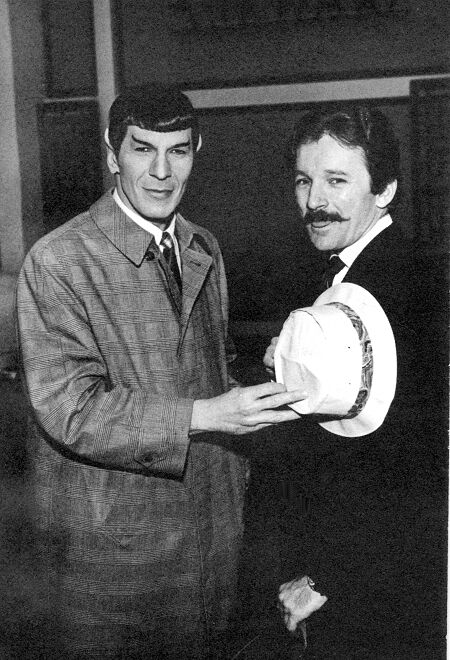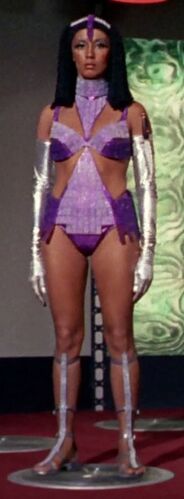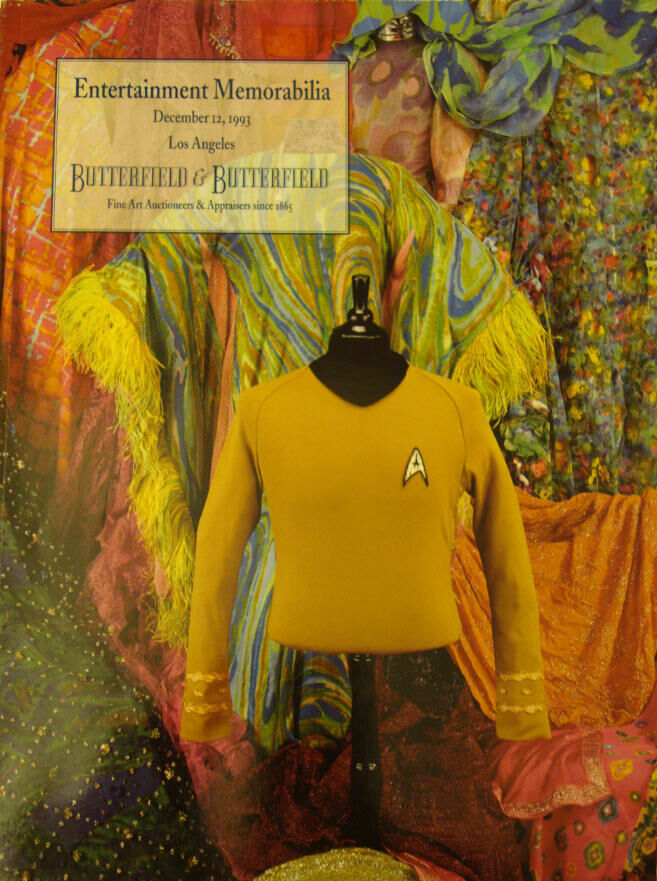William Ware Theiss (20 November 1931 – 15 December 1992; age 61), also credited as William Theiss, worked as the costume designer for the entire run of Star Trek: The Original Series, the abandoned Star Trek: Phase II television project, and for the first season of Star Trek: The Next Generation.
Star Trek
Bill Theiss received credit as "Costume Designer" on the entirety of the Original Series, and as "Costume Creator" and "Executive Consultant" on the first season of The Next Generation, winning an Emmy Award for the episode "The Big Goodbye" in 1988. In the following seasons he was credited as "Original Starfleet Uniforms/Starfleet Uniforms Created By", in the process earning a second Emmy Award nomination for "Elementary, Dear Data".
Theiss' costumes can be seen throughout The Next Generation's first three seasons (only worn by background actors in season 3), and also in the episodes "Suddenly Human", "Identity Crisis", "Violations", "Second Chances", "All Good Things..." and in ENT: "These Are the Voyages...". His original series creations can be also seen in DS9: "Trials and Tribble-ations", ENT: "In a Mirror, Darkly", and ENT: "In a Mirror, Darkly, Part II".
The Original Series
Bill Theiss' distinctive clothing style for "The Veldt", a mid-1960s one-act play from "The World of Ray Bradbury", caught the attention of D.C. Fontana, and introduced Theiss to Gene Roddenberry. Getting along on a personal level, Roddenberry, who was already interviewing candidates for the position, signed Theiss on as costume designer for his first Star Trek pilot, "The Cage", and eventually the upcoming television show. [1]
While Theiss has designed recognizable utilitarian clothing for the show, the most notable ones the iconic Starfleet uniforms, it was his more revealing female garment designs, especially those for "guest" characters, that drew the most attention, as well as some controversy, particularly in feminist circles, or as Theiss himself had put it at the time, "a lot of noise and some indignation". (Inside Star Trek, issue 7, p. 5) Even his female Starfleet uniforms were not beyond reproach, in regard to the short skirt length. Decades later that was playfully hinted at when writers had Jadzia Dax dry-wittedly remark, "...And women wore less..." in the Star Trek: Deep Space Nine fifth season episode "Trials and Tribble-ations", as she donned a Theiss-style Starfleet uniform. (scene 20) In spite of feminist objections, a woman was actually responsible for the introduction of the Starfleet miniskirts and not Roddenberry, as Star Trek lore would have it. It was Grace Lee Whitney, brought in to play Yeoman Janice Rand, who made the suggestion to Theiss, after she had done pre-production publicity shots wearing the second pilot-style uniforms with pants. Whitney explained, "In fact I was the one that made them do that. My concept of ladies in space were not to look like men. I read a lot of comic books as a kid, and I just saw the ladies as looking as we did. Actually it was shorts with the skirt flap over the front. Bill Theiss did that. And the black stockings, the boots, and the legs. I thought it was just outstanding." (Cinefantastique, Vol 27 #11, p. 48-49)

His female garment style can be summed up in the "Theiss Theory of Titillation" – self-coined and first mentioned in Stephen Whitfield's 1968 reference book The Making of Star Trek, p. 360 – which stated "the degree to which a costume is considered sexy is directly dependent upon how accident-prone it appears to be." Not all female guest stars were fully appreciative of Theiss' approach to design, as he recalled on one occasion, "When I first met Jill Ireland, she was a little uneasy about me, and I didn't find out until later it was because she had seen Sherry Jackson's costume, and she was afraid I was going to do as revealing on her." (Inside Star Trek, issue 7, p. 5) Nevertheless, over the next decades, his garments attained near-legendary status, and a number of them, including some of the more titillating ones, were for the first and only time, before being auctioned off, on public display at the 1992-1993 Star Trek Smithsonian Exhibit. [2]
Apart from his clothing, Theiss' other noticeable contribution to the Star Trek universe, was the Vulcan IDIC symbol that he designed for the episode "Is There in Truth No Beauty?". [3]
Theiss was perceived as a demanding and hard driving man by his staff of dressers and costumers, impressed upon by his adages such as "Stop when all work is done – and not before" and "Better rude than late". Colleague and customer Andrea Weaver noted in this regard, "Bill Theiss was a very creative designer. His designs for Star Trek were original rather than distilled from other sources, or redefinitions of previous work. This is what I appreciated about Bill Theiss. I thought he was a truly unique and rare costume creator. Others may have agreed but were more influenced by Bill's personal eccentricities and rudeness..." (Star Trek: The Original Series Sketchbook, p. 119)
Phase II
One decade after the Original Series, Theiss was invited back by Gene Roddenberry to participate as costume designer on the Star Trek: Phase II television project. Theiss heeded the invitation and started to work on the project in July 1977. Partly as a cost saving measure, Theiss did not design entirely new Starfleet uniforms, but updated the existing ones, thereby enabling the re-use of those Original Series uniforms still stored at the studio warehouses, yet stressed that civilian clothing had to be designed from scratch, as he outlined in a memo dated August 23. However, when the final decision was made in November to upgrade the television project to a full motion picture feature, newly-appointed Director Robert Wise – who considered Theiss' costume designs sub-par, coining them "pajamas" – decided in March 1978 that the uniforms had to be completely redesigned, and to this end Wise brought in Robert Fletcher, ending Theiss' participation in the project. (Star Trek Phase II: The Lost Series, pp. 28-29, 39-40, 62)
The Next Generation
Nevertheless, once the outlines for a new television show, Star Trek: The Next Generation, were in place another decade later, Bill Theiss was again invited back by Roddenberry to join the new show in early 1987. Whether or not this had anything to do with him being unceremoniously laid off by Wise a decade before, Theiss started working from what he had done on the original show and the Phase II project, entirely dismissing Fletcher's input for the Star Trek films up to then. While the majority of his designs were utilitarian, a few harkened back to his titillating ones of the Original Series, most notably, the crisscrossing harem girl outfit worn by Tasha Yar (Denise Crosby) in "The Naked Now", and the chest-baring costume worn by Commander William T. Riker (Jonathan Frakes) in "Angel One". Theiss recalled at the time, "Denise has a terrific body and was comfortable exposing it to a degree. She had no problem with her costume." Frakes, however, was more self-conscious, "But that was fine, because as Riker, he was supposed to be uncomfortable with the outfit, and Jonathan is enough of a professional that he used his own uneasiness to his character's advantage. That episode was really tough to design for.", Theiss continued. [4] Theiss opted not to return after the first season, partly due to Roddenberry's uninitiated attorney and business partner Leonard Maizlish, who "destructively" meddled with the creative decision making for the new series, and partly due to the onset of the disease that eventually took his life. (Inside Star Trek: The Real Story, p. 433) Still, it did not prevent him from being nominated for the second Emmy Award, together with his successor Durinda Wood, for the second season.
Asked which of his many creations he counted among his favorites, Theiss stated, "The gown for Leslie Parrish in "Who Mourns for Adonais?" seems to get a lot of attention. [note: at the time Whitfield reported, that while Parrish herself was completely comfortable and had no qualms about wearing and moving in it, it was "the crew and set visitors who had all the qualms". (The Making of Star Trek, p. 361)] Other than that, I don't know. Michelle Phillips' outfit in "We'll Always Have Paris" is quite sensational, and Denise Crosby's punk-of-the-future costume from the sewer scene in "Where No One Has Gone Before" is good. The problem is that a lot of my work is seen on screen for only two to three seconds, and even then it might be in a bad light or angle. Like Commander K'Nera's uniform in "Heart of Glory". I was very proud of that." [5] Incidentally, Theiss was not wrong in his assessment of Parrish's gown, as it brought in ten times the high estimate when it was sold in the below-mentioned auction of 1993.
A private man, Theiss was never one for interviews. The comments he made to Whitfield for his 1968 book, a 1968-1969 two-part interview, conducted by D.C. Fontana for the fanzine Inside Star Trek, and the 1988 unpublished interview, on the occasion of his Emmy Award win, are the only ones known to date. (see links below)








Career outside Star Trek

An attendee for eight semesters at the Art Center College of Design in Pasadena, California (which also counts Andrew Probert and Mark Stetson among their alumni), Theiss' first job was as personal assistant to Cary Grant, whose ex-wife, actress Dyan Cannon, Theiss cited as having considerable influence on his career. (Star Trek: The Original Series Sketchbook, p. 116) His first contribution to films was the 1960 movie Spartacus, albeit uncredited. Theiss continued to work in theater, film, and television for more than thirty years. His work included, among others, the 1971 films Harold and Maude (featuring Ellen Geer and photographed by John A. Alonzo) and Pretty Maids All in a Row (produced by Roddenberry). During his career Theiss earned three "Academy Award for Costume Design" nominations for Bound for Glory (1976), Butch and Sundance: The Early Days (1979), and Heart Like a Wheel (1983), though his one Star Trek Emmy Award remained the only motion picture award he ever won in his career.
Theiss died in 1992, a victim of AIDS, at the age of 61. Theiss apparently retained ownership over most of his creations, as a large number of his Original Series creations – pulled halfway through from the New York City venue of the Smithsonian exhibit – were sold off as part of his estate in the December 1993 The William Ware Theiss Estate Auction, the proceeds of which he willed to "Project Angel Food", an LA-based non-profit agency that served hundreds of meals on a daily basis to those challenged by HIV-AIDS, cancer, and other diseases.
Emmy Awards
- 1988 Emmy Award win as "Costume Designer" in the category "Outstanding Costume Design for a Series" for TNG: "The Big Goodbye", sole winner
- 1989 Emmy Award nomination as "Starfleet uniforms creator" in the category "Outstanding Costume Design for a Series" for TNG: "Elementary, Dear Data", shared with Durinda Wood, costume designer
Star Trek interviews
- "Aliens – Dressed and Undressed", Stephen E. Whitfield, The Making of Star Trek, Part IV: Chapter 6, pp. 355-361, September 1968
- Inside Star Trek, D.C. Fontana,
- "Behind the Camera: William Ware Theiss", issue 6, December 1968, pp. 5-8
- "Behind the Camera: William Ware Theiss (continued)", issue 7, January 1969, pp. 4-8
Further reading
Related topic
External links
- William Ware Theiss at Wikipedia
- William Ware Theiss at the Internet Movie Database
- William Ware Theiss profile(X) at StarTrek.com
- William Ware Theiss profile at Forgotten Trek
- The Next Generation Costume Design at Forgotten Trek
- 1968 William Ware Theiss Inside Star Trek interview at Star Trek Prop, Costume & Auction Authority
- 1988 Bill Theiss: The Lost Interview at Star Trek Prop, Costume & Auction Authority
- 1988 Bill Theiss: The Lost Interview(X) at Phaser Resource(X)
